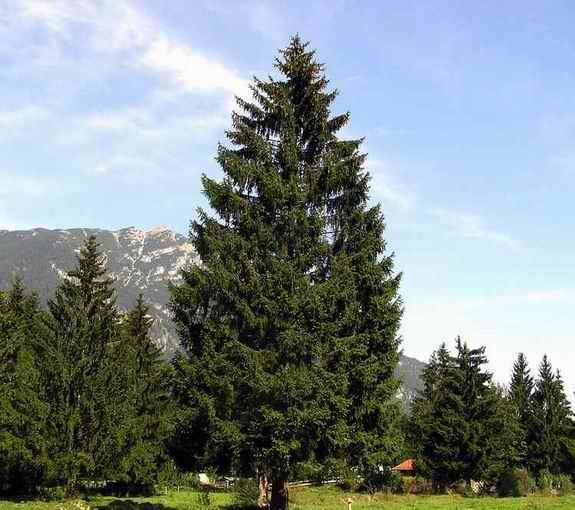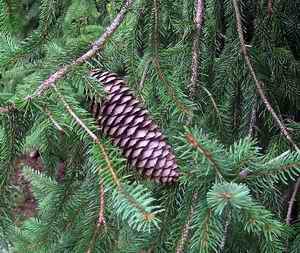|
Return to Hiker's Notebook Home Page
Common Name: Norway Spruce, Red fir - Both Norway and Spruce are associated with the general geographic areas with which the tree was originally associated. The word spruce is derived from an alteration of Pruce, the name of the Prussian state in Old French; spruce trees were imported primarily from Prussia to the other European countries. Norway is a more modern adjectival addition to convey a Nordic provenance.
Scientific Name: Picea abies - The generic name is literally the Latin word for "pitch pine" from the Greek pissa meaning pitch; Picea was the commonly used for pine, spruce and fir trees. Abies is the Latin word for the European silver fir (Abies picea) from abeo which means "to rise" or "rising one"; the implication is that the tree rises to a great height. An alternative species name is Picea excelsa. Excelsus means elevated.
Norway spruce is native to Northeastern Europe and is one of the most important species of tree on the Eurasian continent. Its range extends from Norway and Prussia (now northern Germany and Poland) eastward to the Ural Mountains and southward to northern Greece. Because of its hardiness and adaptability, it has been introduced to most of the world's suitable temperate habitats; it has become widely naturalized in eastern North America as a result.
Spruce trees can be distinguished from fir trees (Abies spp) by their needles and by their cones. The needles of a spruce tree are quadrangular in cross-section while those of the fir tree are flattened; a simple test is to roll the needle between the thumb and the forefinger; if it is a spruce needle, it will readily rotate. The cones of the spruce tree hang downward from the branches whereas those of the fir tree are directed upward. P. abies has the largest cone among the spruces, ranging in size from 9 to 17 centimeters according to age. After the seeds are dispersed from the cone, it falls from the tree. Fir tree cones remain attached until they decompose. The common name "red fir" is due to the reddish bark of the tree that flakes off as the tree matures.
Norway Spruce trees and their derivative products are used in a variety of applications that range from ornamental to medicinal. Its rapid growth of about three feet per year and nearly perfect conical shape once made it a prized Christmas tree. However, its popularity waned with the extension of the holiday period; the needles fall off about two weeks after cutting. Rapid growth coupled with inherent resistance to fungal diseases and insect infestation has also made the tree ideal for reforestation. It is frequently used for windbreaks as it can tolerate winds of up to 100 knots. Norway Spruce wood is light and relatively strong; as it is less resinous than pine or fir, it is valued in millwork for lumber, barrel staves, boat siding and as pulpwood in the paper industry. The wood grain is of an appropriate size, concentration and alignment so as to enhance the resonance of sound. Spruce wood is used for piano sounding boards and in the crafting of violin bodies.
The pharmaceutical Pix Bugundica or, more colloquially Burgundy Pitch, has been listed in the British and U. S. Pharmacopoeias since the late 19th Century as "the resinous exudation obtained from the stem of the Picea excelsa, melted and strained." It was named for the province of Burgundy in eastern France, though it is not certain to have ever been collected there. The resin is harvested by removing the bark and cutting grooved channels in the wood to allow for the agglomeration of the effluent. The resultant chunks were removed with chisels, melted in large caldrons and strained through coarse cloth to produce a hard, reddish to yellowish brown thickly viscous fluid.
Burgundy pitch is the basic material for a number of varnishes and medicinal products. With the heat of the body, it becomes fusible and is applied to the skin as a rubefacient (skin-reddening) plaster that was used to alleviate the pain attendant to rheumatism and in the treatment of chest and abdominal problems; the slow but inexorable revulsion of the skin drawing the inflammation away from the afflicted area of the body. Some individuals are very sensitive to the resin, however, and a severe skin reaction with intense pain and swelling can result. It is currently sold as an incense that conveys a forest-like fragrance to the air with imputed strengthening and regenerative properties. It has a Material Safety Data Sheet (MSDS) that warns against skin and lung irritation. |

